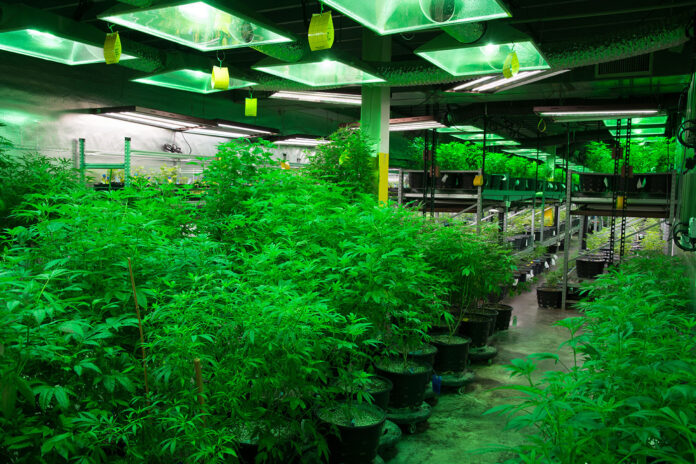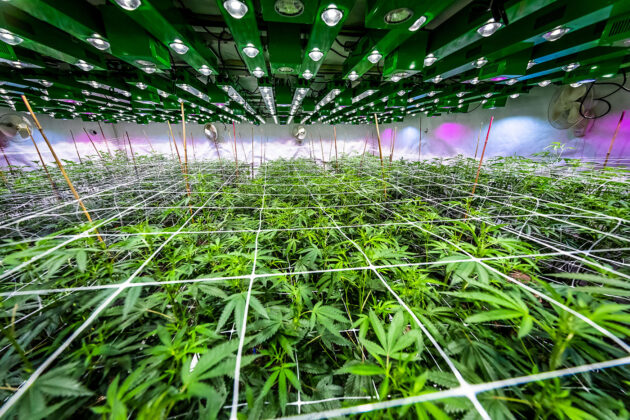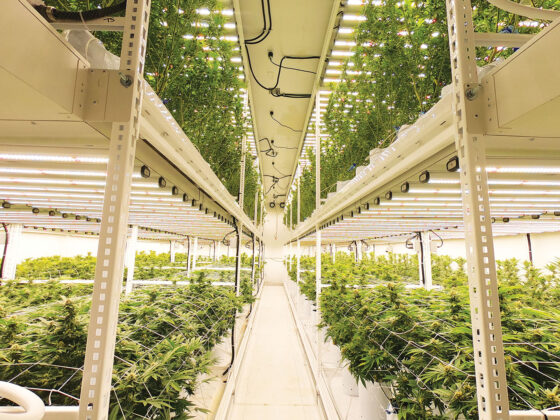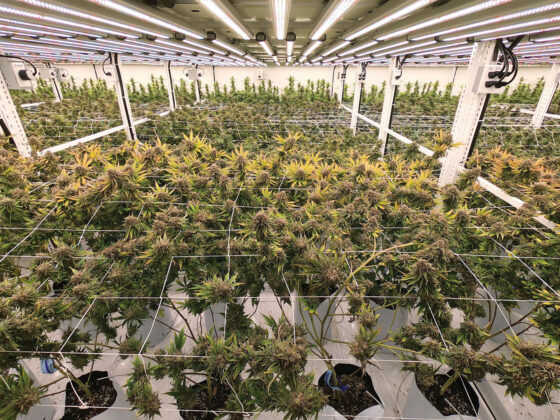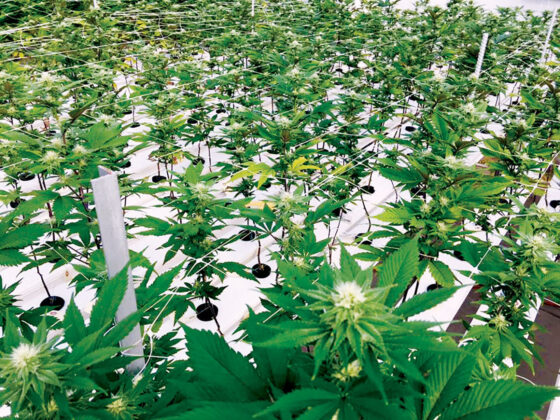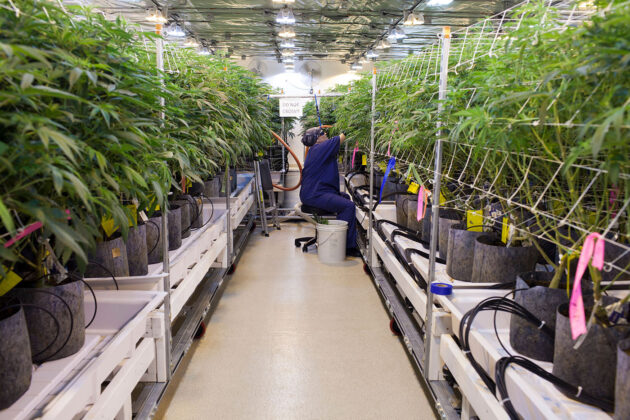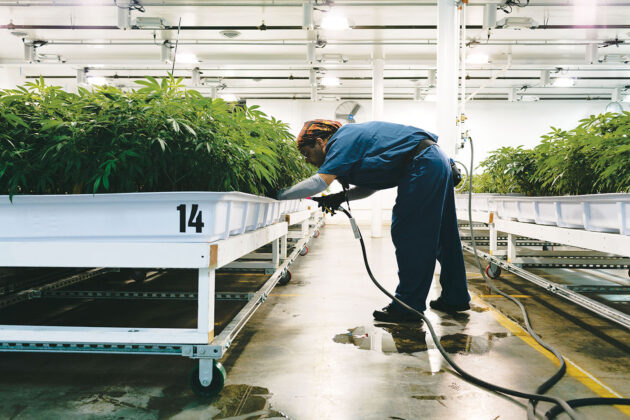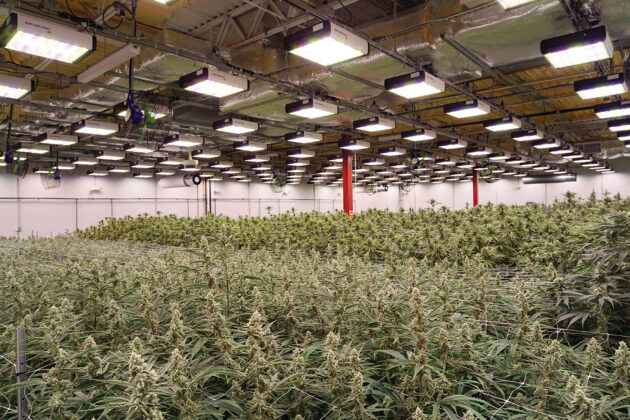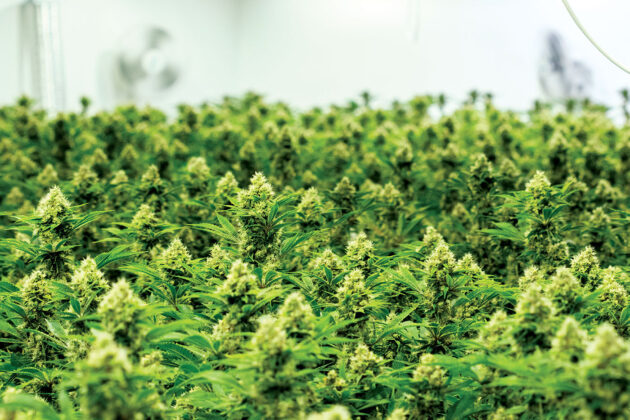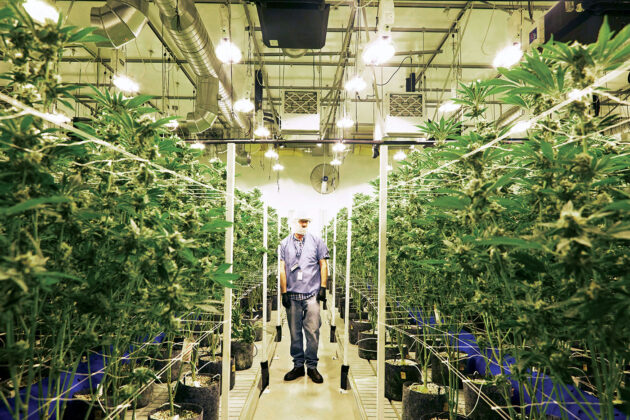When growers in the United States began cultivating cannabis indoors in the 1980s and ’90s, the technology was limited. The equipment required to set up a standard grow room amounted to a few high-intensity lights, fans, a dehumidifier and, if you wanted to get fancy, a CO2 regulator. Local “hydroponics” shops carried three or four brands for each product—all nearly identical.
But as with every other major agricultural industry, technological advances have changed the indoor cannabis game considerably over the past few decades, especially on the commercial side of the industry where hundreds of thousands of dollars are at stake with each harvest. When big corporations design and build new grow facilities, they look for the latest, greatest technology and equipment to ensure an efficient, steady operation. Despite the advances in greenhouse tech and the organic appeal of sun-grown outdoor flower, ultra-frosty indoor buds are still consumer favorites, especially as more states in the Midwest and on the East Coast join the party.
Indoor cannabis cultivation professionals now have the opportunity to push both genetics and yields into uncharted territory with sensors that monitor and software that analyzes every moment in a plant’s lifecycle. Now the question is, “Which technologies will transcend the hype, prove their worth, and become the new standards in an industry that is expected to generate almost $20 billion in the U.S. this year?”
That conversation starts with three simple letters.
HID or LED?
One of the biggest and most contentious debates in indoor cultivation over the past decade has been the performance of HID (high-intensity discharge) lights versus tech-savvy, energy-efficient LED (light-emitting diode) lamps. HPS (high-pressure sodium) lights from manufacturers like Gavita dominate the HID market and have been the de facto standard in indoor cannabis cultivation for decades. Talk to many old-school growers, and they will scoff at the idea of switching to LED, saying LEDs don’t penetrate the canopy, aren’t reliable, or are simply too expensive to justify the switch.
LED lighting technology has made enormous strides over the past few years and will ascend to dominance as the industry moves forward and becomes more data-driven and eco-conscious. In the current environment, however, many established growers on the West Coast remain firmly in the HID camp and are hesitant to change anything when they are producing high-quality flower with cultivars that have been happily basking under HPS spectrums for years.
One of the leading light manufacturers in the U.S. is Atlanta-based Revolution Microelectronics, which has designed and built some of the highest-performing HID lamps on the market over the past decade. Chief Technology Officer Greg Richter possesses more than thirty years of electronics and systems engineering experience; he designed custom-built aircraft instrumentation and automated agriculture controllers before he got into the lighting business.
One of his first efforts, Revolution’s Deva DE HPS light, broke four world performance records, increasing efficiency by more than 2 percent over all other HIDs on the market at the time, according to co-founder and Chief Executive Officer Marisa McRainey. “Greg really knocked it out of the park with that design, and for a few years after that I would say to him, ‘Hey, let’s do an LED light. It really seems like the industry is moving that way, and it would be more efficient, too,’” she said. “And Greg would always tell me, ‘I’m sorry, [but] the diodes just aren’t there yet.’”
A few years ago Richter finally changed his tune after LED manufacturers improved some of the key technologies—transistors, drivers, chips, converters—that compose the “brains” that control the lights, spectrums, and heat output. Five years ago, Revolution Micro was 100-percent in the HID camp, Richter said, but today the company’s new projects on the East Coast are 100-percent LEDs.
“The entire East Coast is going LED because it’s the new way, and new construction is almost exclusively LED,” Richter said. “It doesn’t make sense to say, ‘I want to grow 20 percent less cannabis per square foot.’ If you’re going to raise $10 million to build a facility, go ahead and spend $11 million and you’ll make $2 million back in your first cycle. That’s why all the big guys are going LED. They have MBAs saying it makes no sense to [work with] it otherwise.
“On the West Coast, a lot of the real savvy guys are retrofitting,” he added. “As their HPS fixtures fail, they’re going room by room with LED and learning how to [work with] it.”
Revolution Micro’s LED lights produce more light while creating less heat than HPS fixtures, which lose 5 percent of their brightness in the first eight weeks and continue to get dimmer after that, according to Richter. In addition, LEDs have a much longer lifetime. McRainey noted products from an increasing number of lighting companies are receiving certification from agencies including the Federal Trade Commission, the Canadian Standards Organization, and DesignLights Consortium, a nonprofit group that tests energy-efficient lighting products.
Cultivation conundrum
Growing pains and across-the-board adjustments are unavoidable when switching from HID lamps to LEDs, but most growers find the benefits outweigh the challenges. “LEDs out-yield, out-produce, and can result in higher quality than HPS lights 100 percent of the time if the growers can adapt to it,” Richter said. “But if you switch your lighting to higher intensity and better spectrum and don’t change the rest of the stuff, it doesn’t work. So it’s adapt or die.”
While the future of the industry undoubtedly will have an LED spectrum, the here and now for many growers is a complicated equation with considerations that go beyond mere efficiencies and yields.
“The only hesitation I would have is, let’s say I’ve been in the industry long enough to establish a brand based on a certain profile expression and flavor, and I’m worried it’s not going to transfer perfectly with LEDs,” said Jesse Porter, sales director for InSpire Transpiration Solutions. “If I take these strains I’ve developed and bred and grown under HID, it may potentially take me a year to dial in those plants for LED or breed them under LED in order to get thoroughbreds that express in that space. So there is an adjustment time, and you should be heading toward that goal of breeding and focusing on genetics that thrive under LED. That’s the future. Everyone is going to have to adopt LED, whether or not it’s mandated, just because it is so efficient.”
Keith Schulz, co-founder and chief operating officer at 3 Agriculture in Fort Collins, Colorado, recently helped Nokhu Labs transform its grow room from a traditional HID setup into a vertically-stacked environment that employs ThinkGrow LEDs. By converting the single-tier canopy into a multi-tier setup, Nokhu was able to more than double its grow space and reduce its lighting energy consumption, Schulz said. The company received about $50,000 in rebates to offset the expense of the lighting and ventilation systems.
“We went into every one of their flower rooms over a few weeks period and took light readings and created an average [photosynthetically active radiation] level that we were then going to try to mimic with the LEDs,” explained Schulz. “When we deployed the LED system, we wanted to give the plants the same levels of light, but now we change the spectrum. What they found was, through the entire growth cycle, they’re never going to use more than 70 percent of the full power of the LEDs to achieve what they were doing with their 1000-watt HPS lights. So they actually reduced their overall electrical input.”
As a result of the LED upgrade, Schulz said Nokhu will be able to cut its production costs considerably, and he expects the company will recoup its investment within the first few harvests. After the first harvest, Nokhu reported its flower quality was consistent with or better than under HPS lights. Its Tropicana Banana and Colin OG, specifically, did much better under LED. The THC, CBD, and other cannabinoid levels varied under LEDs, but not more than +/- 5 percent.
Schulz has been working as a sustainable agricultural solution specialist for the past five years. He said there are many more reliable LED manufacturers now and more objective and transparent testing standards via the DesignLights Consortium and other groups.
“I really love that the DLC is focused on agricultural LED testing. They have over 300 products on the DLC-qualified product listings to date,” he said. “To qualify for [the list], there are specific standards a fixture needs to adhere to, like warranty length. The DLC listing shows specific data based on independently produced test results, like efficiency and actual power draw per fixture. So we analyze the specifics of a fixture based on that data, not relying on a data sheet but from a performance perspective—how that product will perform on the farm.”
‘A symphony of weed’
Beyond a grow room’s basic environmental variables—temperature, humidity, CO2 levels—indoor growers in today’s industry have to be on top of (or at least aware of) more arcane and complex concepts such as vapor pressure differential, photomorphogenesis, and external static pressure. This is where equipment specialists and consultants including those at InSpire Transpiration Solutions earn their keep. The company works with a collection of manufacturing partners to design customized HVAC systems that combine dehumidification and air conditioning into a single integrated unit with a dashboard to control all the critical variables from temperature and dehumidification to CO2 regulation and lighting stages.
Porter travels the country consulting on grow rooms of all sizes, helping companies design and incorporate HVAC systems that complement the other essential components of their operations, with the goal of improving product quality and yields across the board. One of the trends he sees in modern indoor grows is more precise “crop steering” with environmental controllers that can optimize everything from humidity and temperature to transpiration rates and feeding schedules.
“Back in the day, it was like, ‘Oh, I want to stress my plant,’ and some crop steering is just that,” he said. “But realistically, it’s more about trying to find good genetics and keeping them as happy as possible from seed to compost. That’s the real driver for performance and consistency.
“It’s really about how to get control of fertigation and lighting,” he continued. “If you’re going to bring in more light intensity, now you need to bring in more fertigation because that plant is going to eat more, she’s going to drink more, and she’s going to need more dehumidification in the space and better airflow. So if you don’t bring that whole symphony together, you just end up with some kid in the corner banging on a drum and telling you it’s music.”
When the symphony of equipment and genetics starts to come together, it looks something like what Team Elite Genetics has built in its Southern California grow rooms. When co-founder and President Steve Castillo started branding Elite’s flower in 2014, he realized marketing was going to be a big part of the game going forward. So, he started entering competitions and has won twenty-six High Times Cannabis Cup awards for flowers and extracts. Castillo uses InSpire’s HVAC system in his grow rooms and can program and customize the environmental conditions that each of the ten to fifteen cultivars in his rotation prefers.
Castillo acknowledges the writing is on the wall with LED lighting and other indoor grow equipment that automates processes and bumps up yields. But as a craft grower who produces some of the most prized flower in California, he still uses HID lights and is able to command premium prices for his products, which are known for their high terpene and cannabinoid content and exotic flavors. “Manufacturers really love me, because I’m all about maximizing the terpene expression in the flower,” he said. “Everything I feed the plant and do is geared toward maximizing the flavor and terpenes that determine the ride of your high.”
One of Elite’s recent flower harvests, a Fatso cultivar from Phinest Cannabis, tested at 44.5-percent total cannabinoids and 41.7-percent total THC—levels that are rarely seen even among top-shelf flower producers.
Even with sophisticated automation tools, keeping a close eye on thousands of plants growing in warehouses with dozens of rooms and hundreds or thousands of lights remains challenging for commercial growers. One of the solutions to the problem is to use high-definition cameras and/or sensors that are integrated with software platforms to provide 24/7 monitoring services and inventory tracking, with alert systems that sound off when potential problems arise.
One such environment is Agrify Corp’s Vertical Farming Unit (VFU)—a high-tech, stackable, micro-climate-controlled module with an integrated software solution known as Agrify Insights. The system uses environmental controls and process automation for real-time control and visualization of all parts of an operation. Each VFU in a facility collects up to 1 million holistic data points a year, which can be used to analyze minute details during the lifecycle of the plants.
“Right now, we’re in the process of correlating all that VFU environmental and microclimate data to results,” said Steve Drucker, Agrify’s senior vice president of software engineering. “We compare all the wet and dry weight results and terpene and cannabinoid percentages. Up until now, it’s been all about how we help growers become better at their jobs by prodding them to a recipe-based format that’s reproducible and gives them the results they want consistently.”
Another company that is knee-deep in data collection is Seattle-based iUNU, which has developed a system that employs artificial intelligence and computer vision to measure the growth of plants on a minute-by-minute basis. Its LUNA system uses autonomous, rail-mounted cameras and canopy-level sensors to monitor plants and detect even the smallest changes, flagging potential problems before they spread. The LUNA application can be installed on computers and mobile devices and allows growers remote access to their analytics.
“THC is one thing you want to measure, but you also might want to know when the hairs change colors or how the fan leaves are looking; know how much extra extraction value you can get from fan leaves in comparison,” said iUNU co-founder and CEO Adam Greenberg. “If you can see it, we can measure it.
“People want to start looking at the growth rate of flowers, so if I want to get an early-harvest strain, well, now we have a whole compare mode and analysis mode,” he added. “It’s a whole phenotyping tool that allows you to do comparative analysis of all plant features of every single inventory item you’ve ever grown underneath the system.”
The iUNU software also can build detailed models of individual plants and has self-learning capabilities designed to help growers identify threats faster and optimize germination and growth rates. Once images are stored in the system, the operator can detect any issues—powdery mildew, pests, light burn, etc.—and address them immediately. With less time spent on addressing problems, growers can spend more time focusing on compelling opportunities like identifying the best phenotypes in the room and increasing crop yields.
Commercial vs. craft
The future of indoor cannabis cultivation may well take several paths, with growers adopting technologies and equipment that make the most sense for their business strategies. Commercial producers are building high-volume cultivation factories that feature the latest equipment and technologies to ensure consistent yields, much of which is destined for the growing extraction market. Meanwhile, many craft growers will continue to take a more cautious approach, incorporating new technologies only when and where they see an opportunity to push their genetics to another level.
“Everyone’s geared toward lowering overhead and increasing revenues, so they are on the autofeed game with rockwool and salt-based feed programs,” said Castillo. “I mean, it’s cheap and it gets you good-looking product that will test high, but you will never achieve the flavor I’m able to get out of the plant using soil, amendments, compost teas, and hand watering. So, there is a give and take there. A lot of technology is making it easier to grow good product, but I always say every corner you cut is one step closer to mids [mid-level, so-so flower].”
On another path are growers in high-volume operations that are producing thousands upon thousands of pounds each year while trying to make sure humans don’t get in the way of technology.
“Back when I was in the aero world, I used to say the cockpit of the future has one pilot and one dog in it. The pilot’s job is to feed the dog, and the dog’s job is to bite the pilot if he touches the computer,” said Richter. “I think growers of the immediate future are not going to be growing so much as being systems managers. We’re moving from a plant being a biological system to being more of a chemical system, and a lot of this is pharmaceutical and nutraceutical now. So, what they want is the same stuff they got last time. The craft guys, yeah, they’re going to always want super-duper flower, but the extractors want consistency.”







